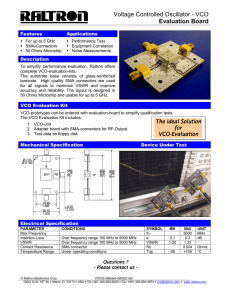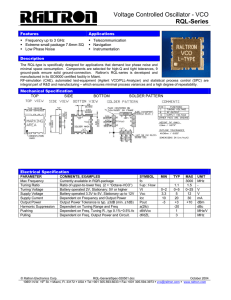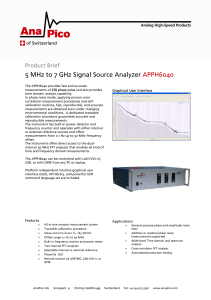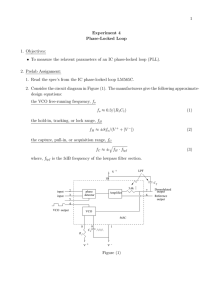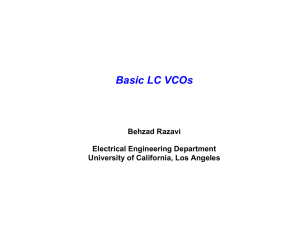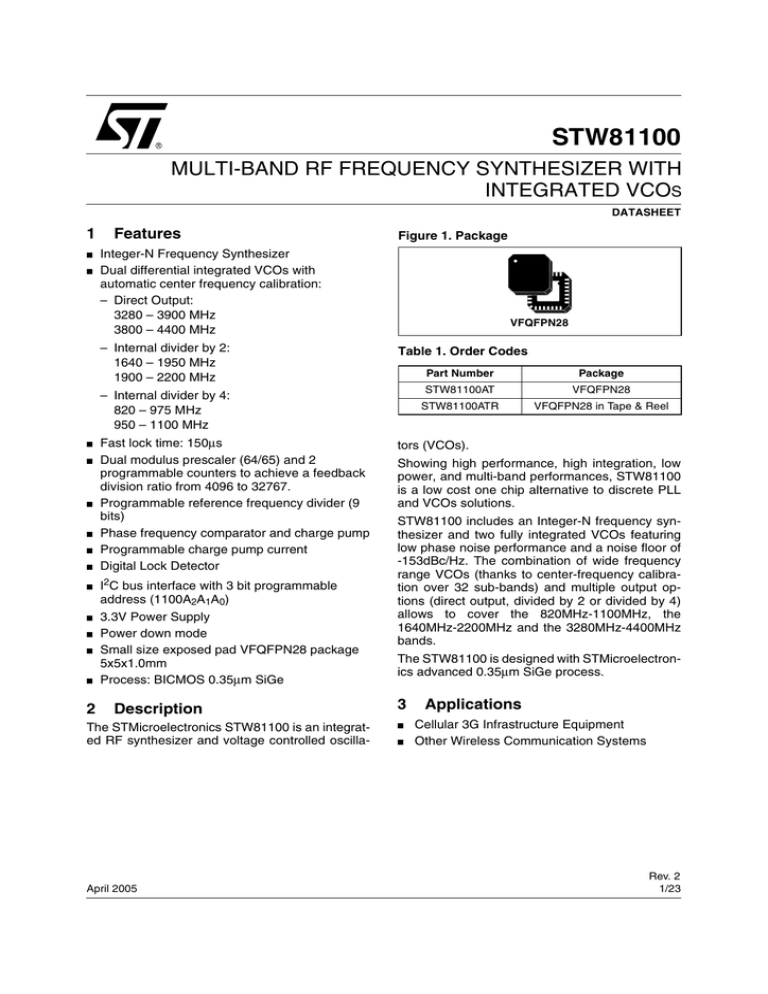
STW81100
MULTI-BAND RF FREQUENCY SYNTHESIZER WITH
INTEGRATED VCOS
DATASHEET
1
■
■
Features
Figure 1. Package
Integer-N Frequency Synthesizer
Dual differential integrated VCOs with
automatic center frequency calibration:
– Direct Output:
3280 – 3900 MHz
3800 – 4400 MHz
– Internal divider by 2:
1640 – 1950 MHz
1900 – 2200 MHz
VFQFPN28
Table 1. Order Codes
Part Number
– Internal divider by 4:
820 – 975 MHz
950 – 1100 MHz
■
■
■
■
■
■
■
■
■
■
■
2
Fast lock time: 150µs
Dual modulus prescaler (64/65) and 2
programmable counters to achieve a feedback
division ratio from 4096 to 32767.
Programmable reference frequency divider (9
bits)
Phase frequency comparator and charge pump
Programmable charge pump current
Digital Lock Detector
I2C bus interface with 3 bit programmable
address (1100A2A1A0)
3.3V Power Supply
Power down mode
Small size exposed pad VFQFPN28 package
5x5x1.0mm
Process: BICMOS 0.35µm SiGe
Description
The STMicroelectronics STW81100 is an integrated RF synthesizer and voltage controlled oscilla-
April 2005
Package
STW81100AT
VFQFPN28
STW81100ATR
VFQFPN28 in Tape & Reel
tors (VCOs).
Showing high performance, high integration, low
power, and multi-band performances, STW81100
is a low cost one chip alternative to discrete PLL
and VCOs solutions.
STW81100 includes an Integer-N frequency synthesizer and two fully integrated VCOs featuring
low phase noise performance and a noise floor of
-153dBc/Hz. The combination of wide frequency
range VCOs (thanks to center-frequency calibration over 32 sub-bands) and multiple output options (direct output, divided by 2 or divided by 4)
allows to cover the 820MHz-1100MHz, the
1640MHz-2200MHz and the 3280MHz-4400MHz
bands.
The STW81100 is designed with STMicroelectronics advanced 0.35µm SiGe process.
3
■
■
Applications
Cellular 3G Infrastructure Equipment
Other Wireless Communication Systems
Rev. 2
1/23
STW81100
Figure 2. Block Diagram
REXT
V SS_ PLL
V DD_ PLL
REF_ IN
OUT BUF N
O UT BUF P
VDD_OUTBUF
VSS_OUTBUF
BUF
DIV2
BUF
VSS_DIV4
VCO
BUF
DIV4
BUF
VDD_DIV4
VSS_CP
VDD_DIV2
REF
Divider
DIV2
DIV4
VSS_DIV2
VDD_CP
P
F
D
VDD_BUFVCO
VSS_BUFVCO
DN
VCO
Divider
BUF
EXTVCO_INP
UP
C
P
ICP
LOCK_DET
EXT
VCO BUF
EXTVCO_INN
ATPGON
I²C BUS
VDD_VCO1
VCO
BUFF
SCL
SDA
ADD0
ADD1
VSS_VCO1
ADD2
VCO
Calibrator
VDD_VCO2
VDD_I2C
VSS_VCO2
VSS_I2C
VDD_ESD
VSS_ESD
EX T_PD
TEST2
T EST 1
VCTRL
VDD_I2C
EXT_PD
SDA
SC L
ADD0
ADD1
AD D2
Figure 3. Pin Connections
VDD_VCO1
ATPGON
VDD_DIV2
VDD_BUFVCO
EXTVCO_INP
VDD_OUTBUF
QFN 28
OUTBUFP
LOCK_DET
TEST2
TEST1
VDD_VCO2
VDD_CP
REF_IN
REXT
VDD_DIV4
I CP
VDD_PLL
VCTRL
OUTBUFN
VDD_ESD
2/23
EXTVCO_INN
STW81100
Table 2. Pin Description
Pin No
Name
Description
Observations
1
VDD_VCO1
VCO power supply
2
VDD_DIV2
Divider by 2 power supply
3
VDD_OUTBUF
Output buffer power supply
4
OUTBUFP
LO buffer positive output
Open collector
5
OUTBUFN
LO buffer negative output
Open collector
6
VDD_DIV4
Divider by 4 power supply
7
VDD_VCO2
VCO power supply
8
VDD_ESD
9
VCTRL
10
ICP
11
REXT
12
VDD_CP
13
TEST1
14
LOCK_DET
15
ESD positive rail power supply
VCO control voltage
PLL charge pump output
External resistance connection for PLL charge
pump
Power supply for charge pump
Test input 1
Used only for testing purpose
Lock detector
CMOS Output
TEST2
Test input 2
Used only for testing purpose
16
REF_IN
Reference frequency input
17
VDD_PLL
18
EXTVCO_INN
External VCO negative input
19
EXTVCO_INP
External VCO positive input
20
VDD_BUFVCO
VCO buffer power supply
21
ATPGON
SCAN mode activated
22
VDD_I2C
I2C bus power supply
23
EXT_PD
Power down hardware
CMOS Input
24
SDA
I2CBUS data line
CMOS Bidir Schmitt triggered
25
SCL
I2CBUS clock line
CMOS Input
26
ADD0
I2CBUS address select pin
CMOS Input
27
ADD1
I2CBUS address select pin
CMOS Input
28
ADD2
I2CBUS address select pin
CMOS Input
PLL digital power supply
3/23
STW81100
Table 3. Absolute Maximum Ratings
Symbol
Parameter
Values
Unit
AVCC
Analog Supply voltage
0 to 4.6
V
DVCC
Digital Supply voltage
0 to 4.6
V
Tstg
Storage temperature
+150
°C
ESD
Electrical Static Discharge
- HBM
- CDM-JEDEC Standard
2
0.5
KV
Table 4. Operating Conditions
Symbol
Parameter
Test conditions
Min
Typ
Max
Unit
AVCC
Analog Supply voltage
3.0
3.3
3.6
V
DVCC
Digital Supply voltage
3.0
3.3
3.6
V
ICC
Current Consumption
100
mA
85
°C
125
°C
Tamb
Operating ambient temperature
Tj
Maximum junction temperature
Rth j-a
-40
Junction to ambient package thermal
resistance
Multilayer JEDEC board
35
°C/W
Table 5. Digital Logic Level
Symbol
4
Parameter
Vil
Low level input voltage
Vih
High level input voltage
Vhyst
Schmitt trigger hysteresis
Vol
Low level output voltage
Voh
High level output voltage
Test conditions
Min
Typ
Max
Unit
0.2*Vdd
V
0.8*Vdd
V
0.8
V
0.4
0.85*Vdd
V
V
Electrical Characteristcs
All Electrical Specifications are intended at 3.3V supply voltage.
Table 6. Electrical Characteristcs
Symbol
Parameter
Test Condition
Min
Typ
Max
Units
Reference input frequency
10
19.2
100
MHz
Reference input sensitivity
0.35
1
1.5
Vpeak
fcomp
Comparison frequency
200
400
10000
KHz
fstep
Frequency step
LO direct output
200
400
10000
KHz
LO with Divider by 2
100
200
5000
KHz
LO with Divider by 4
50
100
2500
KHz
REFERENCE
fref
4/23
STW81100
Table 6. Electrical Characteristcs (continued)
CHARGE PUMP
Symbol
ICP
VOCP
Parameter
ICP sink/source1
Test Condition
Typ
3bit programmable
Output voltage compliance
range
Spurious2,3
Min
0.4
Max
Units
4
mA
Vdd-0.3
V
Direct Output
-65
-54
dBc
Divider by 2
-70
-60
dBc
Divider by 4
-70
-66
dBc
VCOs
KvcoA
KvcoB
Sub-Band 00000
85
105
135
MHz/V
Sub-Band 01111
55
70
95
MHz/V
Sub-Band 11111
35
50
65
MHz/V
Sub-Band 00000
60
75
100
MHz/V
Sub-Band 01111
35
45
60
MHz/V
Sub-Band 11111
20
25
35
MHz/V
VCOA Pushing3
7
10
MHz/V
VCOB Pushing3
9
14
MHz/V
3
V
-20
dBc
VCOA sensitivity3
VCOB sensitivity3
VCO control voltage
0.4
LO Harmonic Spurious
VCO current consumption
25
mA
VCO buffer consumption
15
mA
IDIV2
DIVIDER by 2 consumption
18
mA
IDIV4
DIVIDER by 4 consumption
14
mA
0
dBm
LO OUTPUT BUFFER
POUT
Output level
RL
Return Loss
Matched to 50ohm
15
dB
Current Consumption
DIV4 Buff
26
mA
DIV2 Buff
23
mA
Direct Output
37
mA
ILOBUF
EXTERNAL VCO (Test purpose only)
fINVCO
PIN
VINDC
IEXTBUF
Frequency range
Input level
DC Input level
Current Consumption
VCO Internal Buffer
3.28
4.4
GHz
0
+6
dBm
2
V
15
mA
5/23
STW81100
Table 6. Electrical Characteristcs (continued)
PLL MISCELLANEUS
IPLL
tLOCK
Current Consumption
Input Buffer, Prescaler, Digital
Dividers, misc
10
mA
Lock up time
40 KHz PLL bandwidth; within
1 ppm of frequency error
150
µs
Notes: 1. : see relationship between ICP and REXT in the Circuit Description section (Charge Pump)
2. : Comparison frequency leakage (400KHz) and harmonics
3. : Guaranteed by design and characterization.
Table 7. Phase Noise Performance1)
Parameter
In Band Phase Noise – Closed
Test Condition
Normalized In Band Phase Noise
Floor
In Band Phase Noise Floor
Direct Output
In Band Phase Noise Floor
Divider by 2
Min
Typ
Max
Units
Loop2)
ICP=2mA, PLL BW = 50KHz;
including reference clock contribution
In Band Phase Noise Floor
Divider by 4
-212
dBc/Hz
-212+20log(N)+10log(fcomp)
dBc/Hz
-218+20log(N)+10log(fcomp)
dBc/Hz
-224+20log(N)+10log(fcomp)
dBc/Hz
-39
-37
dBc
-38
-36
dBc
-56
-53
dBc/Hz
PLL Integrated Phase Noise with Divider by 2
Integrated Phase Noise (single
sided) 400Hz to 4MHz
Integrated Phase Noise (single
sided) 100Hz to 25MHz
ICP = 4mA, fcomp = 400KHz
(N = 10000), PLL BW = 15KHz
VCO A Direct (3280MHz-3900MHz) – Open Loop
Phase Noise @ 1 KHz
Phase Noise @ 10 KHz
-83
-82
dBc/Hz
Phase Noise @ 100 KHz
-105
-102
dBc/Hz
Phase Noise @ 1 MHz
-128
-125
dBc/Hz
Phase Noise @ 10 MHz
-148
-145
dBc/Hz
Phase Noise @ 40 MHz
-156
-153
dBc/Hz
-55
-52
dBc/Hz
VCO B Direct (3800MHz-4400MHz) – Open Loop
Phase Noise @ 1 KHz
Phase Noise @ 10 KHz
-82
-79
dBc/Hz
Phase Noise @ 100 KHz
-104
-101
dBc/Hz
Phase Noise @ 1 MHz
-127
-124
dBc/Hz
Phase Noise @ 10MHz
-147
-143
dBc/Hz
Phase Noise @ 40 MHz
-155
-152
dBc/Hz
-62
-59
dBc/Hz
VCO A with divider by 2 (1640MHz-1950MHz) – Open Loop
Phase Noise @ 1 KHz
Phase Noise @ 10 KHz
-89
-86
dBc/Hz
Phase Noise @ 100 KHz
-111
-108
dBc/Hz
Phase Noise @ 1 MHz
-134
-131
dBc/Hz
Phase Noise @ 10 MHz
-150
-148
dBc/Hz
Phase Noise @ 20 MHz
-152
-150
dBc/Hz
Phase Noise Floor @ 40 MHz
-153
-151
dBc/Hz
6/23
STW81100
Table 7. (continued)
Parameter
Test Condition
Min
Typ
Max
Units
VCO B with divider by 2 (1900MHz-2200MHz) – Open Loop
Phase Noise @ 1 KHz
-61
-58
dBc/Hz
Phase Noise @ 10 KHz
-88
-85
dBc/Hz
Phase Noise @ 100 KHz
-110
-107
dBc/Hz
Phase Noise @ 1 MHz
-133
-130
dBc/Hz
Phase Noise @ 10MHz
-150
-148
dBc/Hz
Phase Noise @ 20MHz
-152
-150
dBc/Hz
Phase Noise Floor @ 40 MHz
-153
-151
dBc/Hz
-68
-65
dBc/Hz
dBc/Hz
VCO A with divider by 4 (820MHz-975MHz) – Open Loop
Phase Noise @ 1 KHz
Phase Noise @ 10 KHz
-95
-92
Phase Noise @ 100 KHz
-117
-114
dBc/Hz
Phase Noise @ 1 MHz
-139
-136
dBc/Hz
Phase Noise @ 10MHz
-151
-149
dBc/Hz
Phase Noise Floor @ 40 MHz
-153
-151
dBc/Hz
-67
-64
dBc/Hz
VCO B with divider by 4 (950MHz-1100MHz) – Open Loop
Phase Noise @ 1 KHz
Phase Noise @ 10 KHz
-94
-91
dBc/Hz
Phase Noise @ 100 KHz
-116
-113
dBc/Hz
Phase Noise @ 1 MHz
-138
-135
dBc/Hz
Phase Noise @ 10MHz
-151
-149
dBc/Hz
Phase Noise Floor @ 40 MHz
-153
-151
dBc/Hz
Note 1):
Note 2):
Phase Noise SSB.
VCO amplitude set to maximum value [11].
The phase noise is measured with the Agilent E5052A Signal Source Analyzer.
All the closed-loop performances are specified using a Reference Clock signal at 19.2 MHz with phase noise of -141dBc/Hz
@1KHz offset and -146dBc/Hz @10KHz offset. All figures are guaranteed by design and characterization.
Normalized PN = Measured PN - 20log(N) - 10log(fcomp) where N is the VCO divider ratio (N=B*P+A) and fcomp is the comparison frequency at the PFD input
7/23
STW81100
5
Typical Performance Characteristics
The phase noise is measured with the Agilent E5052A Signal Source Analyzer. All the closed-loop measurements are done with fcomp=800 KHz and using a Reference Clock signal at 19.2 MHz with phase
noise of -141dBc/Hz @1KHz offset and -146dBc/Hz @10KHz offset.
Figure 4. VCO A (Direct output) open loop
phase noise
Figure 6. VCO B (Direct output) open loop
phase noise
Figure 5. VCO A (Direct output) closed loop
phase noise
Figure 7. VCO B (Direct output) closed loop
phase noise
8/23
STW81100
Figure 8. VCO A (Divider by 2 output) closed
loop phase noise
Figure 10. VCO B (Divider by 2 output) closed
loop phase noise
Figure 9. VCO A (Divider by 4 output) closed
loop phase noise
Figure 11. VCO B (Divider by 4 output) closed
loop phase noise
9/23
STW81100
6
General Description
The block diagram of Figure 2 shows the different blocks, which have been integrated to achieve an integer-N PLL frequency synthesizer.
The STW81100 consists of 2 internal low-noise VCOs with buffer blocks, a divider by 2, a divider by 4, a
low-noise PFD (Phase Frequency Detector), a precise charge pump, a 9-bit programmable reference divider, two programmable counters and a dual-modulus prescaler.
The A-counter (6 bits) and B counter (9 bits) counters, in conjunction with the dual modulus prescaler P/
P+1 (64/65), implement an N integer divider, where N = B*P +A.
The division ratio of both reference and VCO dividers is controlled through an I2C bus interface.
All devices operate with a power supply of 3.3 V and can be powered down when not in use.
7
Circuit Description
7.1 Reference input stage
The reference input stage is shown in Figure 12. The resistor network feeds a DC bias at the Fref input
while the inverter used as the frequency reference buffer is AC coupled.
Figure 12. Reference Frequency Input Buffer
VDD
Fref
INV
BUF
Power Down
7.2 Reference Divider
The 9-bit programmable reference counter allows the input reference frequency to be divided to produce
the input clock to the PFD. The division ratio is programmed through the I2C bus interface.
7.3 Prescaler
The dual-modulus prescaler 64/65 takes the CML clock from the VCO buffer and divides it down to a manageable frequency for the CMOS A and B counters. It is based on a synchronous 4/5 core which division
ratio depends on the state of the modulus input.
7.4 A and B Counters
The A (6 bits) and B (9 bits) counters, in conjunction with the dual modulus prescaler make it possible to
generate output frequencies which are spaced only by the reference frequency divided by the reference
division ratio. Thus, the division ratio and the VCO output frequency are given by these formulas:
N=BxP+A
10/23
( B ⋅ P + A ) ⋅ F ref
F VCO = ----------------------------------------R
STW81100
where:
– FVCO: output frequency of VCO.
– P: modulus of dual modulus prescaler.
– B: division ratio of the main counter.
– A: division ratio of the swallow counter.
– Fref: input reference frequency.
– R: division ratio of reference counter.
– N: division ratio of PLL
For a correct work of the VCO divider, B must be strictly higher than A. A can take any value ranging from
0 to 63. The range of the N number can vary from 4096 to 32767.
Figure 13. VCO Divider Diagram
VCOBUF-
Prescaler
64/65
VCOBUF+
To PFD
modulus
6 bit
A counter
9 bit
B counter
7.5 Phase frequency detector (PFD)
The PFD takes inputs from the reference and the VCO dividers and produces an output proportional to
the phase error. The PFD includes a delay gate that controls the width of the anti-backlash pulse. This
pulse ensures that there is no dead zone in the PFD transfer function.
Figure 6 is a simplified schematic of the PFD.
Figure 14. PDF Diagram
VDD
Up
D FF
Fref
R
Delay
Fref
VDD
R
D FF
Down
ABL
11/23
STW81100
7.6 Lock Detect
This signal indicates that the difference between rising edges of both UP and DOWN PFD signals is found
to be shorter than the fixed delay (roughly 5 ns). Lock Detect signal is high when the PLL is locked.
When Power Down is activated, Lock Detect is let to high level (Lock Detect consumes current only during
PLL transients).
7.7 Change Pump
This block drives two matched current sources, Iup and Idown, which are controlled respectively by UP
and DOWN PFD outputs. The nominal value of the output current is controlled by an external resistor (to
be connected to the REXT input pin) and a selection among 8 by a 3 bit word.
The minimum value of the output current is: IMIN = 2*VBG/REXT (VBG~1.17 V)
Table 8. Current Value vs Selection
CPSEL2
CPSEL1
CPSEL0
Current
Value for REXT=9.1 KΩ
0
0
0
IMIN
0.25 mA
0
0
1
2*IMIN
0.50 mA
0
1
0
3*IMIN
0.75 mA
0
1
1
4*IMIN
1.00 mA
1
0
0
5*IMIN
1.25 mA
1
0
1
6*IMIN
1.50 mA
1
1
0
7*IMIN
1.75 mA
1
1
1
8*IMIN
2.00 mA
Note: The current is output on pin ICP. During the VCO auto calibration, ICP and VCTRL pins are forced to VDD/2.
Figure 15. Loop Filter Connection
VDD
VCTRL
BUF
C3
Charge
Pump
R3
ICP
R1
C1
BUF
Cal bit
12/23
C2
STW81100
7.8 Voltage Controlled Oscillators
7.8.1 VCO Selection
Within STW81100 two low-noise VCOs are integrated to cover a wide band from 3280MHz to 4400MHz
(direct output), from 1640MHz to 2200MHz (selecting divider by 2) and from 820MHz to 1100MHz (selecting divider by 4).
VCO A frequency range 3280MHz-3900MHz
VCO B frequency range 3800MHz-4400MHz
7.8.2 VCO Frequency Calibration
Both VCOs can operate on 32 frequency ranges that are selected by adding or subtracting capacitors to
the resonator. These frequency ranges are intended to cover the wide band of operation and compensate
for process variation on the VCO center frequency.
An automatic selection of the range is performed when the bit SERCAL rises from “0” to “1”. The charge
pump is inhibited and the pins ICP & VCTRL are at VDD/2 volts.
Then the ranges are tested to select the one which with this VCO input voltage is the nearest to the desired
output frequency (Fout = N*Fref/R). When this selection is achieved the signal ENDCALB (which means
End of Calibration) falls to “0”, then the charge pump is enabled again and SERCAL should be reset to “0”
before the next channel step.
The PLL has just to perform fine adjustment around VDD/2 on the loop filter to reach Fout, which enables
a fast settle.
Figure 16. VCO Sub-Bands Frequency Characteristics
The SERCAL bit should be set to “1” at each division ratio change. It should be noted that in order to reset
the autocalibrator State Machine after a power-up, and anyway before the first calibration, the INITCAL bit
should be set to “1” and back to “0” (this operation is automatically performed by the Power On Reset circuitry). The calibration takes approximately 7 periods of the Comparison Frequency.
The maximum allowed fcomp to perform the calibration process is 1 MHz. Using an higher fcomp the following procedure should be adopted:
1.
Calibrate the VCO at the desired frequency with an fcomp less than 1 MHz
2.
Set the A, B and R dividers ratio for the desired fcomp
13/23
STW81100
7.8.3 VCO Voltage Amplitude Control
The bits A0 and A1 control the voltage swing of the VCO. The following table gives the voltage level expected on the resonator nodes.
Table 9.
8
Code A[1:0]
Differential output voltage (Vp)
00
1.1
01
1.3
10
1.9
11
2.1
I2C bus interface
Data transmission from microprocessor to the STW81100 takes place through the 2 wires (SDA and SCL)
I2C-BUS interface. The STW81100 is always a slave device.
The I2C-bus protocol defines any device that sends data on to the bus as a transmitter and any device that
reads the data as receiver. The device that controls the data transfer is known as the Master and the others as the slave. The master will always initiate the transfer and will provide the serial clock for synchronization.
8.1 General Features
8.1.1 Power ON Reset
The device at Power ON is able to configure itself to a fixed configuration, with all programmable bits set
to factory default setting.
8.1.2 Data Validity
Data changes on the SDA line must only occur when the SCL is LOW. SDA transitions while the clock is
HIGH are used to identify START or STOP condition.
Figure 17.
SDA
SCL
DATA LINE
STABLE DATA
VALID
CHANGE
DATA
ALLOWED
8.1.3 START condition
A Start condition is identified by a HIGH to LOW transition of the data bus SDA while the clock signal SCL
is stable in the HIGH state. A Start condition must precede any command for data transfer.
14/23
STW81100
8.1.4 STOP condition
A LOW to HIGH transition of the data bus SDA identifies start while the clock signal SCL is stable in the
HIGH state. A STOP condition terminates communications between the STW81100 and the Bus Master.
Figure 18.
SCL
SDA
START
STOP
8.1.5 Byte format and acknowledge
Every byte transferred on the SDA line must contain bits. Each byte must be followed by an acknowledge
bit. The MSB is transferred first.
An acknowledge bit is used to indicate a successful data transfer. The bus transmitter, either master or
slave, will release the SDA bus after sending 8 bits of data. During the 9th clock pulse the receiver pulls
the SDA low to acknowledge the receipt of 8 bits data.
Figure 19.
SCL
1
2
3
7
8
9
//
SDA
MSB
//
START
ACKNOWLEDGMENT
FROM RECEIVER
8.1.6 Device addressing
To start the communication between the Master and the STW81100, the master must initiate with a start
condition. Following this, the master sends onto the SDA line 8 bits (MSB first) corresponding to the device
select address and read or write mode.
The first 7 MSB‘s are the device address identifier, corresponding to the I2C-Bus definition. For the
STW81100 the address is set as “1100A2A1A0”, 3bits programmable. The 8th bit (LSB) is the read or write
operation bit (RW; set to 1 in read mode and to 0 in write mode).
After a START condition the STW81100STW81100 identifies on the bus the device address and, if
matched, it will acknowledge the identification on SDA bus during the 9th clock pulse.
8.1.7 Single-byte write mode
Following a START condition the master sends a device select code with the RW bit set to 0. The
STW81100 gives an acknowledge and waits for the internal sub-address (1 byte). This byte provides access to any of the internal registers.
After the reception of the internal byte sub-address the STW81100 again responds with an acknowledge.
A single byte write to sub-address 00H would affect DATA_OUT[119:112], so a single byte write with subaddress 07H would affect DATA_OUT[63:56] and so on.
15/23
STW81100
Table 10.
S
1100A2A1A0
0
ack
sub-address byte
ack
DATA IN
ack
P
8.1.8 Multi-byte write mode
The multi-byte write mode can start from any internal address. The master sends the data bytes and each
one is acknowledged. The master terminates the transfer by generating a STOP condition.
The sub-address decides the starting byte. A multi byte with sub-address 07H and 5 DATA_IN byte would
affect the bytes starting from DATA_OUT[63:56] to DATA_OUT[31:24] and so on.
Table 11.
S
1100A2A1A0
0
ack
sub-address byte
ack
DATA IN
ack
....
DATA IN
ack
P
8.1.9 Current Byte Address Read
In the current byte address read mode, following a START condition, the master sends the device address
with the rw bit set to 1 (No sub-address is needed as there is only 1 byte read register). The STW81100
acknowledges this and outputs the data byte. The master does not acknowledge the received byte, but
terminates the transfer with a STOP condition.
Table 12.
S
1100A2A1A0
0
ack
sub-address byte
ack
DATA IN
ack
....
DATA IN
8.2 Timing Specification
Figure 20. Data and clock
SDA
SCL
tcwl
tcs
tch
tcwh
Table 13.
16/23
Symbol
Tcs
Parameter
Data to clock set up time
Minimum time (ns)
2
Tch
Data to clock hold time
2
Tcwh
Clock pulse width high
10
Tcwl
Clock pulse width low
5
ack
P
STW81100
Figure 21. Start and Stop
SDA
SCL
tstop2 tstop1
tstart1 tstart2
Table 14.
Symbol
Parameter
Minimum time (ns)
Tstart1,2
Clock to data start time
2
Tstop1,2
Data to clock down stop time
2
Figure 22. Ack
SDA
SCL
8
9
td1
td2
Table 15.
Symbol
Parameter
Maximum time (ns)
Td1
Ack begin delay
2
Td2
Ack end delay
2
8.3 I2C Register
STW81100 has 6 write-only registers and 1 read-only register.
The following table gives a short description of the write-only registers list.
17/23
STW81100
Table 16.
HEX CODE
DEC CODE
DESCRIPTION
0x00
0
FUNCTIONAL_MODE
0x01
1
B_COUNTER
0x02
2
A_COUNTER
0x03
3
REF_DIVIDER
0x04
4
CALIBRATION
0x05
5
CONTROL
Table 17. Functional_Mode
MSB
LSB
b7
b6
b5
b4
b3
b2
b1
b0
PD7
PD6
PD5
PD4
PD3
PD2
PD1
PD0
FUNCTIONAL_MODE register is used to select different functional mode for the STW81100 synthesizer
according to the following table:
Table 18.
Decimal value
Description
0
Power down mode
1
Enable VCO A, output frequency divided by 2
2
Enable VCO B, output frequency divided by 2
3
Enable external VCO, output frequency divided by 2
4
Enable VCO A, output frequency divided by 4
5
Enable VCO B, output frequency divided by 4
6
Enable external VCO, output frequency divided by 4
7
Enable VCO A, direct output
8
Enable VCO B, direct output
9
Enable external VCO, direct output
Table 19. B_COUNTER
MSB
LSB
b7
b6
b5
b4
b3
b2
b1
b0
B8
B7
B6
B5
B4
B3
B2
B1
B[8:1] Counter value (bit B0 in the next register)
18/23
STW81100
Table 20. A_COUNTER
MSB
LSB
b7
b6
b5
b4
b3
b2
b1
b0
B0
A5
A4
A3
A2
A1
A0
RS
Bit B0 for B Counter, A Counter value and bit R8 for Reference divider.
Table 21. REF_DIVIDER
MSB
LSB
b7
b6
b5
b4
b3
b2
b1
b0
R7
R6
R5
R4
R3
R2
R1
R0
Reference Clock divider ratio R[7:0] (bit R8 in the previous register).
The LO output frequency is programmed by setting the proper value for A,B and R according to the following formula:
F REF_CLK
F OUT = D R ⋅ ( B ⋅ 64 + A ) ⋅ -------------------------R
{
where DR equals
1
for Direct Output
0.5
for Output Divided by 2
0.25
for Output Divided by 4
Table 22. Calibration
MSB
LSB
b7
b6
b5
b4
b3
b2
b1
b0
INIT CAL
SER CAL
SEL EXT CAL
CAL 0
CAL 1
CAL 2
CAL 3
CAL 4
This register controls VCO calibrator.
INITCAL: resets the auto-calibrator State Machine (writing to “1” and back to “0”)
SERCAL: at “1” starts the VCO auto-calibration (should be reset to “0” at the end of calibration)
SELEXTCAL: at “1” selects control word EXTCAL[4:0] for the VCO
EXTCAL[4:0]: control word for the VCO
Table 23. CONTROL
b7
b6
b5
b4
b3
b2
b1
b0
PLL_A0
PLL_A1
CP SEL 0
CP SEL 1
CP SEL 2
NA
NA
NA
The CONTROL register is used to set the VCO output voltage amplitude and the Charge Pump Current.
PLL_A[1:0]: VCO amplitude
CPSEL[2:0]: Charge Pump output current
19/23
STW81100
Table 24. READ-ONLY REGISTER
b7
b6
b5
b4
b3
b2
b1
b0
ILLEG
AL_SUBAD0
END CALB
LOCK_DET
INT CAL4
INT CAL3
INT CAL2
INT CAL1
INT CAL0
This register is automatically addressed in the ‘current byte address read mode’.
ILLEGAL_SUBADD: gives “1” if the sub-address value is not correct
ENDCALB: at “0” means end of auto-calibration phase
LOCK_DET: “1” when PLL is locked
INTCAL[4:0]: internal value of the VCO control word
Figure 23. Application Diagram
DIV2
BUF
LO_OUT
OUTBUFP
50 Ω
BUF
OUTBUFN
DIV4
BUF
EXT LO
EXTVCO_INP
EXT VCO
BUFF
EXTVCO_INN
CHARGE
PUMP
VCTRL
REF_IN
20/23
ICP
REXT
STW81100
9
Package Information
Figure 24. VFQFPN28 Mechanical Data & Package Dimensions
REF.
mm
inch
MIN.
TYP.
MAX.
MIN.
TYP.
MAX.
0.800
0.900
1.000
0.031
0.035
0.039
A1
0.020
0.050
0.0008 0.0019
A2
0.650
1.000
0.025
0.250
0.300
0.007 0.0098 0.012
5.000
5.150
0.191
A
A3
0.200
b
0.180
D
4.850
D1
0.039
0.0078
4.750
0.197
0.203
0.187
D2
1.250
2.700
3.250
0.049
0.106
0.128
E
4.850
5.000
5.150
0.191
0.197
0.203
E1
E2
4.750
1.250
e
L
P
2.700
0.187
3.250
0.049
0.500
0.350
0.550
OUTLINE AND
MECHANICAL DATA
0.106
0.128
0.020
0.750
0.60
0.014
0.022
0.029
0.0236
K
14˚
14˚
ddd
0.080
0.003
Notes: 1) VFQFPN stands for Thermally Enhanced Very thin Fine
pitch Quad Packages No lead.
Very thin: A = 1.00 Max.
2) The pin #1 identifier must be existed on the top surface
of the package by using indentation mark or other feature of package body.
Exact shape and size of this feature is optional.
VFQFPN-28 (5x5x1.0mm)
Very Fine Quad Flat Package No lead
7655832 A
21/23
STW81100
10 Revision History
Table 25. Revision History
22/23
Date
Revision
Description of Changes
March 2005
1
First Issue
April 2005
2
Changed the maturity from Preliminary to Final datasheet.
Modified sections: 1, 2, 4 (Tables 6, 7).
Added new section 5 "Typical Performance Characteristics".
Modified sub-section 7.8.2 “VCO Frequency Calibration”.
Changed “Package Informations”.
STW81100
Information furnished is believed to be accurate and reliable. However, STMicroelectronics assumes no responsibility for the consequences
of use of such information nor for any infringement of patents or other rights of third parties which may result from its use. No license is granted
by implication or otherwise under any patent or patent rights of STMicroelectronics. Specifications mentioned in this publication are subject
to change without notice. This publication supersedes and replaces all information previously supplied. STMicroelectronics products are not
authorized for use as critical components in life support devices or systems without express written approval of STMicroelectronics.
The ST logo is a registered trademark of STMicroelectronics.
All other names are the property of their respective owners
© 2005 STMicroelectronics - All rights reserved
STMicroelectronics group of companies
Australia - Belgium - Brazil - Canada - China - Czech Republic - Finland - France - Germany - Hong Kong - India - Israel - Italy - Japan Malaysia - Malta - Morocco - Singapore - Spain - Sweden - Switzerland - United Kingdom - United States of America
www.st.com
23/23

